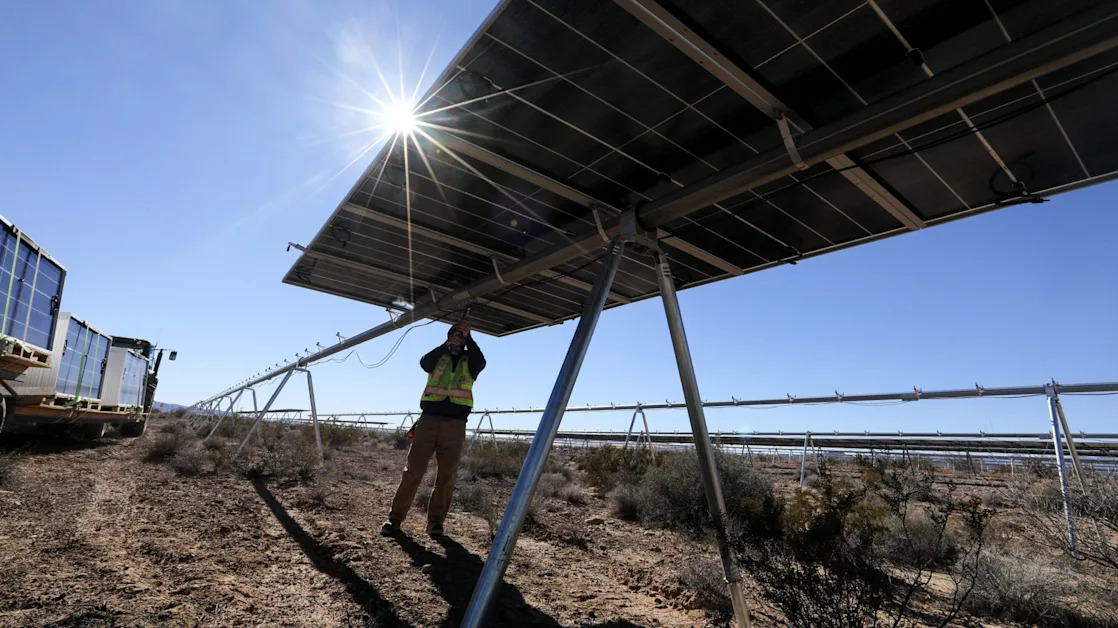Leading U.S. solar manufacturer First Solar saw its stock plunge almost 9% on April 30 after dropping its midpoint earnings guidance by nearly 20% for 2025 because of the potential impacts of President Trump’s tariffs.
The renewable energy industry is struggling because of tariffs, supply chain costs, and political headwinds in the U.S. But solar is considered the best-positioned of the sector, and First Solar, which focuses on utility-scale solar, is recognized as the U.S. bellwether in part because most of its manufacturing is domestic.
Still, First Solar makes about 45% of its equipment in Asia, especially Vietnam, Malaysia, and India, where tariffs could either have modest impacts or result in the “probable” shutdown of the company’s international plants in the second half of the year if they’re not lowered, First Solar CEO Mark Widmar said in the earnings call.
“While the implementation of certain new trade policies was a possibility with the change in administration, the new tariff regime imposed earlier this month has introduced significant challenges to 2025 that were not known at the start of the year,” Widmar said.
Under the current tariff proposal from the White House, imports from Vietnam face 46% tariffs, while India and Malaysia stand at 26% and 24%, respectively.
“It becomes uneconomical to ship a product with a 46% tariff into the U.S. and be able to sell that to an end customer,” Widmar said.
“There's a lot of strategies that we could do once we understand the policy environment and the tariff environment that we're going to be in, but I don't know any of that right now,” he added. “So, our guide is taking the limited information that we have, applying that, and it does reflect a meaningful reduction to volume in the low end for sure.”
More modest tariffs closer to 10% would remain impactful, but prove manageable, he said.
The midpoint guidance of First Solar’s earnings per diluted share fell from $18.50 to $15. However, the guidance range is wide with the high end at $17.50 and the low at $12.50. Widmar said they're being as “transparent” as possible.
First solar dropped its midpoint net sales guidance by 10% and its midpoint capital spending by 11%.
Widmar said First Solar remains well-positioned in the long term with strong fundamentals and growing production in the U.S. A new plant in Alabama is continuing to ramp up, and a Louisiana plant is under construction.
First Solar’s stock initially plunged by about 13% in early trading but rebounded to an 8.3% dip. Still, the stock was down almost 30% year to date and by 55% from its all-time high in May 2024.
Meanwhile, residential solar manufacturer Enphase Energy had its stock fall April 30 to a nearly five-year low since its pandemic bottom in 2020.
Eyes on Congress
Brett Castelli, equity analyst for Morningstar, said the wild card to watch is what the Congress does with renewable energy tax credits during the upcoming budget reconciliation process because some Republicans want to dramatically cut them.
“There’s just a lot of uncertainty for anyone building solar projects right now,” Castelli said.
If Congress cuts or eliminates tax credits, then projects would speed up in the short term—and then dramatically slow down—to beat the expiration of the current credits, Castelli said.
“You’d want to get those projects in the ground as quickly as possible,” he said. “The uncertainty now sort of freezes everyone and they don’t know whether to speed up or slow down.”
He said the onshore wind sector is more “subdued” than solar, and offshore wind—in the U.S. at least—is worse off still. President Trump holds a personal animosity against offshore wind turbines.
Earlier in April, the Trump administration ordered construction halted on Equinor’s Empire Wind project offshore of New York, arguing that the permitted process may have been rushed under President Biden. The order was a major escalation of the president’s war against wind by blocking a fully permitted project that had already begun construction.
First Solar also relies on lots of Chinese components for its battery-storage systems, which would face heavy tariffs, as would the rest of the battery industry, which remains heavily dependent on China.
Still, Castelli said there is reason for longer-term bullishness if tax credits can be preserved and tariffs are resolved. Power demand is increasing both domestically and worldwide.
“You have all these new data centers coming in and you need lots of new generation.”


